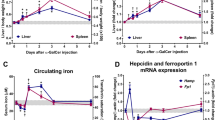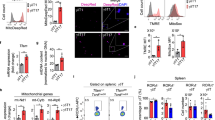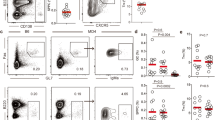Abstract
Splenic marginal zone B (MZB) cells, positioned at the interface between circulating blood and lymphoid tissue, detect and respond to blood-borne antigens. Here we show that MZB cells in mice activate a homeostatic program in response to a high-cholesterol diet (HCD) and regulate both the differentiation and accumulation of T follicular helper (TFH) cells. Feeding mice an HCD resulted in upregulated MZB cell surface expression of the immunoregulatory ligand PDL1 in an ATF3-dependent manner and increased the interaction between MZB cells and pre-TFH cells, leading to PDL1-mediated suppression of TFH cell motility, alteration of TFH cell differentiation, reduced TFH abundance and suppression of the proatherogenic TFH response. Our findings reveal a previously unsuspected role for MZB cells in controlling the TFH–germinal center response to a cholesterol-rich diet and uncover a PDL1-dependent mechanism through which MZB cells use their innate immune properties to limit an exaggerated adaptive immune response.
This is a preview of subscription content, access via your institution
Access options
Access Nature and 54 other Nature Portfolio journals
Get Nature+, our best-value online-access subscription
$29.99 / 30 days
cancel any time
Subscribe to this journal
Receive 12 print issues and online access
$209.00 per year
only $17.42 per issue
Buy this article
- Purchase on Springer Link
- Instant access to full article PDF
Prices may be subject to local taxes which are calculated during checkout






Similar content being viewed by others
Accession codes
References
Libby, P., Lichtman, A.H. & Hansson, G.K. Immune effector mechanisms implicated in atherosclerosis: from mice to humans. Immunity 38, 1092–1104 (2013).
Ait-Oufella, H., Sage, A.P., Mallat, Z. & Tedgui, A. Adaptive (T and B cells) immunity and control by dendritic cells in atherosclerosis. Circ. Res. 114, 1640–1660 (2014).
Sage, A.P. & Mallat, Z. Multiple potential roles for B cells in atherosclerosis. Ann. Med. 46, 297–303 (2014).
Tsiantoulas, D., Sage, A.P., Mallat, Z. & Binder, C.J. Targeting B cells in atherosclerosis: closing the gap from bench to bedside. Arterioscler. Thromb. Vasc. Biol. 35, 296–302 (2015).
Ait-Oufella, H. et al. B cell depletion reduces the development of atherosclerosis in mice. J. Exp. Med. 207, 1579–1587 (2010).
Kyaw, T. et al. Conventional B2 B cell depletion ameliorates whereas its adoptive transfer aggravates atherosclerosis. J. Immunol. 185, 4410–4419 (2010).
Kyaw, T., Tipping, P., Bobik, A. & Toh, B.H. Protective role of natural IgM-producing B1a cells in atherosclerosis. Trends Cardiovasc. Med. 22, 48–53 (2012).
Sage, A.P. et al. BAFF receptor deficiency reduces the development of atherosclerosis in mice—brief report. Arterioscler. Thromb. Vasc. Biol. 32, 1573–1576 (2012).
Candando, K.M., Lykken, J.M. & Tedder, T.F. B10 cell regulation of health and disease. Immunol. Rev. 259, 259–272 (2014).
Rosser, E.C. & Mauri, C. Regulatory B cells: origin, phenotype, and function. Immunity 42, 607–612 (2015).
Dang, V.D., Hilgenberg, E., Ries, S., Shen, P. & Fillatreau, S. From the regulatory functions of B cells to the identification of cytokine-producing plasma cell subsets. Curr. Opin. Immunol. 28, 77–83 (2014).
Sage, A.P. et al. Regulatory B cell–specific interleukin-10 is dispensable for atherosclerosis development in mice. Arterioscler. Thromb. Vasc. Biol. 35, 1770–1773 (2015).
Strom, A.C. et al. B regulatory cells are increased in hypercholesterolaemic mice and protect from lesion development via IL-10. Thromb. Haemost. 114, 835–847 (2015).
Pillai, S. & Cariappa, A. The follicular versus marginal zone B lymphocyte cell fate decision. Nat. Rev. Immunol. 9, 767–777 (2009).
Clement, M. et al. Control of the T follicular helper–germinal center B-cell axis by CD8+ regulatory T cells limits atherosclerosis and tertiary lymphoid organ development. Circulation 131, 560–570 (2015).
Grasset, E.K. et al. Sterile inflammation in the spleen during atherosclerosis provides oxidation-specific epitopes that induce a protective B-cell response. Proc. Natl. Acad. Sci. USA 112, E2030–E2038 (2015).
Saito, T. et al. Notch2 is preferentially expressed in mature B cells and indispensable for marginal zone B lineage development. Immunity 18, 675–685 (2003).
Tanigaki, K. et al. Notch–RBP-J signaling is involved in cell fate determination of marginal zone B cells. Nat. Immunol. 3, 443–450 (2002).
Witt, C.M., Won, W.J., Hurez, V. & Klug, C.A. Notch2 haploinsufficiency results in diminished B1 B cells and a severe reduction in marginal zone B cells. J. Immunol. 171, 2783–2788 (2003).
Gold, E.S. et al. ATF3 protects against atherosclerosis by suppressing 25-hydroxycholesterol-induced lipid body formation. J. Exp. Med. 209, 807–817 (2012).
Gilchrist, M. et al. Systems biology approaches identify ATF3 as a negative regulator of Toll-like receptor 4. Nature 441, 173–178 (2006).
De Nardo, D. et al. High-density lipoprotein mediates anti-inflammatory reprogramming of macrophages via the transcriptional regulator ATF3. Nat. Immunol. 15, 152–160 (2014).
Hoetzenecker, W. et al. ROS-induced ATF3 causes susceptibility to secondary infections during sepsis-associated immunosuppression. Nat. Med. 18, 128–134 (2011).
Herieka, M. & Erridge, C. High-fat meal induced postprandial inflammation. Mol. Nutr. Food Res. 58, 136–146 (2014).
Good-Jacobson, K.L. et al. PD-1 regulates germinal center B cell survival and the formation and affinity of long-lived plasma cells. Nat. Immunol. 11, 535–542 (2010).
Cinamon, G., Zachariah, M.A., Lam, O.M., Foss, F.W. Jr. & Cyster, J.G. Follicular shuttling of marginal zone B cells facilitates antigen transport. Nat. Immunol. 9, 54–62 (2008).
Pereira, J.P., Kelly, L.M. & Cyster, J.G. Finding the right niche: B-cell migration in the early phases of T-dependent antibody responses. Int. Immunol. 22, 413–419 (2010).
Cyster, J.G., Dang, E.V., Reboldi, A. & Yi, T. 25-Hydroxycholesterols in innate and adaptive immunity. Nat. Rev. Immunol. 14, 731–743 (2014).
Ma, C.S., Deenick, E.K., Batten, M. & Tangye, S.G. The origins, function, and regulation of T follicular helper cells. J. Exp. Med. 209, 1241–1253 (2012).
Zinselmeyer, B.H. et al. PD-1 promotes immune exhaustion by inducing antiviral T cell motility paralysis. J. Exp. Med. 210, 757–774 (2013).
Weill, J.C., Weller, S. & Reynaud, C.A. Human marginal zone B cells. Annu. Rev. Immunol. 27, 267–285 (2009).
Descatoire, M. et al. Identification of a human splenic marginal zone B cell precursor with NOTCH2-dependent differentiation properties. J. Exp. Med. 211, 987–1000 (2014).
Zotos, D. et al. IL-21 regulates germinal center B cell differentiation and proliferation through a B cell–intrinsic mechanism. J. Exp. Med. 207, 365–378 (2010).
Lee, J.Y. et al. The transcription factor KLF2 restrains CD4+ T follicular helper cell differentiation. Immunity 42, 252–264 (2015).
Moriyama, S. et al. Sphingosine-1-phosphate receptor 2 is critical for follicular helper T cell retention in germinal centers. J. Exp. Med. 211, 1297–1305 (2014).
Weber, J.P. et al. ICOS maintains the T follicular helper cell phenotype by down-regulating Krüppel-like factor 2. J. Exp. Med. 212, 217–233 (2015).
Kroenke, M.A. et al. Bcl6 and Maf cooperate to instruct human follicular helper CD4 T cell differentiation. J. Immunol. 188, 3734–3744 (2012).
Liu, X. et al. Transcription factor achaete-scute homologue 2 initiates follicular T-helper-cell development. Nature 507, 513–518 (2014).
Choi, Y.S. et al. ICOS receptor instructs T follicular helper cell versus effector cell differentiation via induction of the transcriptional repressor Bcl6. Immunity 34, 932–946 (2011).
Soh, S.Y. et al. NKT cell hyporesponsiveness leads to unrestrained accumulation of marginal zone B cells in hypercholesterolemic apolipoprotein E–deficient mice. J. Immunol. 197, 3894–3904 (2016).
Rosser, E.C. et al. Regulatory B cells are induced by gut microbiota–driven interleukin-1β and interleukin-6 production. Nat. Med. 20, 1334–1339 (2014).
Bankovich, A.J., Shiow, L.R. & Cyster, J.G. CD69 suppresses sphingosine 1–phosophate receptor-1 (S1P1) function through interaction with membrane helix 4. J. Biol. Chem. 285, 22328–22337 (2010).
Hannedouche, S. et al. Oxysterols direct immune cell migration via EBI2. Nature 475, 524–527 (2011).
Liu, C. et al. Oxysterols direct B-cell migration through EBI2. Nature 475, 519–523 (2011).
Xu, H. et al. Follicular T-helper cell recruitment governed by bystander B cells and ICOS-driven motility. Nature 496, 523–527 (2013).
Gotsman, I. et al. Proatherogenic immune responses are regulated by the PD-1/PD-L pathway in mice. J. Clin. Invest. 117, 2974–2982 (2007).
Bu, D.X. et al. Impairment of the programmed cell death-1 pathway increases atherosclerotic lesion development and inflammation. Arterioscler. Thromb. Vasc. Biol. 31, 1100–1107 (2011).
Khan, A.R. et al. PD-L1hi B cells are critical regulators of humoral immunity. Nat. Commun. 6, 5997 (2015).
Johnston, R.J. et al. Bcl6 and Blimp-1 are reciprocal and antagonistic regulators of T follicular helper cell differentiation. Science 325, 1006–1010 (2009).
Sage, P.T., Francisco, L.M., Carman, C.V. & Sharpe, A.H. The receptor PD-1 controls follicular regulatory T cells in the lymph nodes and blood. Nat. Immunol. 14, 152–161 (2013).
Dong, H. et al. B7-H1 determines accumulation and deletion of intrahepatic CD8+ T lymphocytes. Immunity 20, 327–336 (2004).
Hartman, M.G. et al. Role for activating transcription factor 3 in stress-induced beta-cell apoptosis. Mol. Cell. Biol. 24, 5721–5732 (2004).
Binder, C.J. et al. Pneumococcal vaccination decreases atherosclerotic lesion formation: molecular mimicry between Streptococcus pneumoniae and oxidized LDL. Nat. Med. 9, 736–743 (2003).
Chou, M.Y. et al. Oxidation-specific epitopes are dominant targets of innate natural antibodies in mice and humans. J. Clin. Invest. 119, 1335–1349 (2009).
Kim, D. et al. TopHat2: accurate alignment of transcriptomes in the presence of insertions, deletions and gene fusions. Genome Biol. 14, R36 (2013).
Trapnell, C. et al. Differential analysis of gene regulation at transcript resolution with RNA–seq. Nat. Biotechnol. 31, 46–53 (2013).
Acknowledgements
We acknowledge A. Petrunkina, E. Perez, C. Bowman, S. McCallum, J. Markovic Djuric and N. Savinykh in the Phenotyping Hub of the Department of Medicine (University of Cambridge) for their help in flow cytometry and sorting and M. Ozsvar Kozma (Medical University of Vienna) for help in antibody measurements. We also acknowledge M. Ma for support during library preparation for RNA–seq. This work was supported by BHF grant no. PG/15/76/31756, BHF grant no. PG/13/73/30466, ERC grant no. 2891164 and EC FP7 VIA grant no. HEALTH-F4-2013-603131 to Z.M. and by SAF2013-45543-R from the Spanish Ministry of Economy and Competitiveness (MINECO) to J.L.d.l.P. M.N. was first supported by a Sara Borrell grant (CD09/00452) from the Instituto Nacional de Salud Carlos III (Spain) and then by a 2-year BHF Project Grant. M.N. has also received funding from the People Programme (Marie Curie Actions) of the European Union's Seventh Framework Programme (FP7/2007-2013) under REA grant agreement no. 608765. We acknowledge measurements of lipids in blood by K. Burling. The Wellcome Trust supported the Cambridge Mouse Biochemistry Laboratory.
Author information
Authors and Affiliations
Contributions
M.N. and Z.M. conceived the study; M.N. designed, performed and analyzed the results of experiments; A.P.S. performed experiments and provided advice on design and discussion; Y.L. performed time-lapse microscopy experiments; S.N., J.R. and D.M. performed experiments related to the atherosclerosis studies; L.M., A.F., L.K. and N.F. helped significantly with flow cytometry, animal work and immunohistochemistry, respectively; S.W. provided and analyzed human spleens crucial to this study; D.T. performed and interpreted blood antibody measurements; R.S., M.K. and J.L.d.l.P. developed and provided mice and cells crucial for the paper; B.Y.H.L. performed bioinformatic analyses on the RNA–seq data; G.S.H.Y. supervised and interpreted the RNA–seq analyses; C.J.B. advised on antibody measurement and contributed significantly to the intellectual content of the paper; Z.M. supervised the entire study; and M.N. and Z.M. prepared the manuscript. All authors contributed to and approved the final manuscript.
Corresponding author
Ethics declarations
Competing interests
The authors declare no competing financial interests.
Supplementary information
Supplementary Text and Figures
Supplementary Figures 1–7 and Supplementary Tables 1,2. (PDF 8143 kb)
Rights and permissions
About this article
Cite this article
Nus, M., Sage, A., Lu, Y. et al. Marginal zone B cells control the response of follicular helper T cells to a high-cholesterol diet. Nat Med 23, 601–610 (2017). https://doi.org/10.1038/nm.4315
Received:
Accepted:
Published:
Issue Date:
DOI: https://doi.org/10.1038/nm.4315
This article is cited by
-
Atherosclerosis antigens as targets for immunotherapy
Nature Cardiovascular Research (2023)
-
B cell-specific knockout of AID protects against atherosclerosis
Scientific Reports (2023)
-
Antigen-specific B cells direct T follicular-like helper cells into lymphoid follicles to mediate Mycobacterium tuberculosis control
Nature Immunology (2023)
-
Human circulating CD24hi marginal zone B cells produce IgM targeting atherogenic antigens and confer protection from vascular disease
Nature Cardiovascular Research (2023)
-
Antibodies in action: the role of humoral immunity in the fight against atherosclerosis
Immunity & Ageing (2022)



